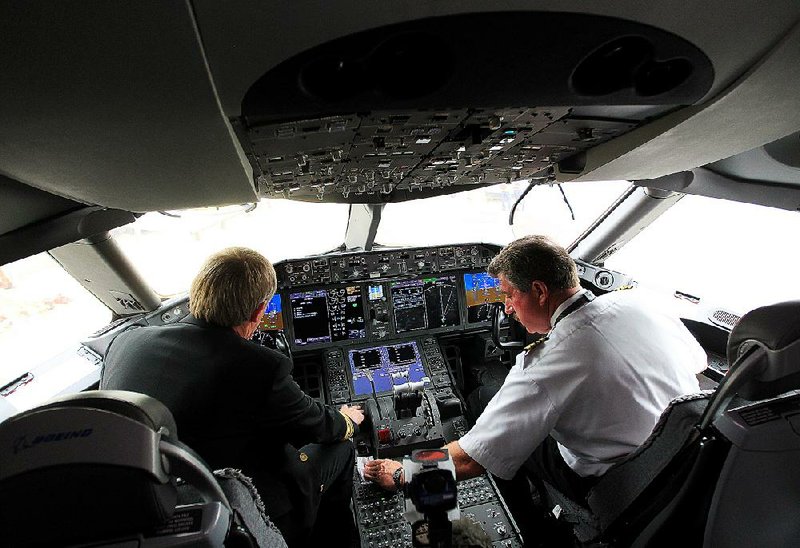Boeing Co.’s 787 Dreamliner cleared another hurdle in restoring its image Monday as United Airlines resumed flights after the jet’s lithium-ion battery flaws forced a three-month grounding.
United Flight 1 flew from Houston to Chicago, with Boeing Chief Executive Officer Jim McNerney and Jeff Smisek, CEO of United parent United Continental Holdings Inc., both on board.
U.S. Dreamliner service gives Boeing a chance to buff the 787’s reputation in the world’s biggest aviation market after the first grounding of an entire fleet type since 1979. Qatar Airways Ltd., Ethiopian Airlines Enterprise and Air India Ltd. are the other carriers whose 787s are flying commercially again.
“I trust Boeing that they know what they are doing,” said Flight 1 passenger Peter Wolf, a 25-year-old video photographer for an office-furniture trade publication. Wolf didn’t know he was booked on a 787 until he reached the gate in Houston and saw a small stage and backdrop with United’s logo. “Lithium batteries aren’t an exact science yet.”
Boeing’s shares fell 20 cents Monday to close at $98.72.
Boeing and United, both based in Chicago, reinforced the flight’s importance by putting their CEOs aboard. When ANA Holdings Inc., the biggest Dreamliner user, flew a test flight in April, the planemaker’s representative was Boeing Commercial Airplanes President Ray Conner.
“They need to show that this aircraft is truly ready for prime time,” said Richard Aboulafia, vice president of Teal Group, a Fairfax, Va.-based aerospace consultant. “You can get customer confidence back pretty quickly in this business if you can show a consistent pattern of no glitches.”
Returning the plastic-composite 787 to service will let United add new routes such as Denver-Tokyo, which is scheduled to begin June 10 and wouldn’t be financially feasible with bigger aircraft. Boeing bills the wide-body jet as achieving greater fuel efficiency and longer range than any peers in service.
“If you want to be the world’s leading airline, which is what we at United are working for, you’ve got to have the world’s leading airplane,” Smisek told reporters and passengers at a small ceremony at Houston’s George Bush Intercontinental Airport as the carrier served chocolate-chip cookies and water. “We’re delighted to have the 787 back in service. It’s a terrific airplane. Our customers love it.”
With Boeing’s McNerney standing nearby, Smisek acknowledged the lost revenue and inconvenience of the grounding.
“I’ll tell you again, it was a fairly expensive piece of sculpture to have on the ground,” said Smisek, who also flew on United’s first 787 trip, in November. The twinengine planes have a list price of $206.8 million for the 787-8 and $243.6 million for the 787-9 version.
McNerney apologized again for the early struggles with the 787, which was more than 3½ years late when it reached its first customer in 2011.
“We are very sorry about the delay that was caused by some of the technology work-arounds that we had to implement,” he said. “But the promise of this airplaneremains unchanged. We are confident of that. More importantly, we are confident in the safety of this aircraft. Safety means everything to us. It’s in our DNA.”
ANA, Japan Airlines Co. and LOT Polish Airlines SA say they plan to start returning 787s to service in the first week of June, while the other operator, Latam Airlines Group SA, said May 15 that its Dreamliners would fly in “coming days.”
The U.S. Federal Aviation Administration cleared the Dreamliner for service last month after a Jan. 16 order that the planes be parked for two lithium-ion battery malfunctions. The first was an incident on a Japan Airlines 787 in Boston that U.S. safety investigators later called anuncontrolled chain reaction that charred the battery.
Boeing redesigned the battery to include more protection around individual cells to contain any overheating, a steel case to prevent fire and a tube that would vent any fumes outside the fuselage.
The changes mean that any other failures would be “no longer a safety concern,” Boeing 787 Chief Project Engineer Mike Sinnett said in April. He was scheduled to join McNerney and Smisek on today’s flight.
Since ANA first received the 787 in September 2011, Boeing delivered 50 of the aircraft through April.
Boeing’s first post-grounding delivery was a handover this month to Tokyo-based ANA.
Business, Pages 25 on 05/21/2013

